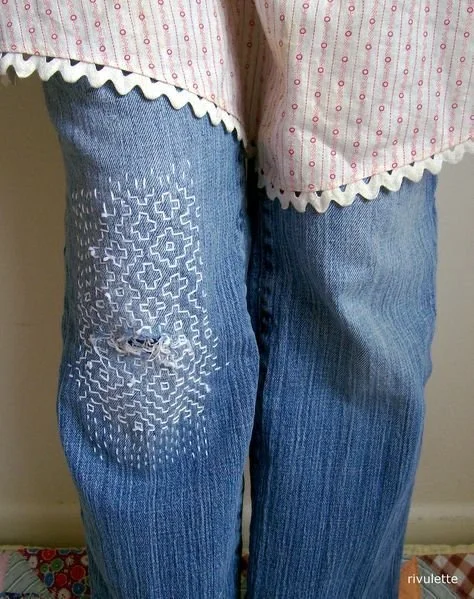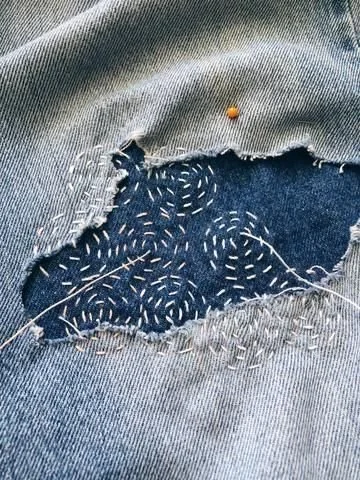Mending Threads with Tradition in Mind: The Arts of Sashiko, Boro, Kantha, Rafoogari, and Darning
Image: Sashiko-mended jeans on Rivulette, from My Vintage Sewing.
By Ifra Shahid
Whether it’s a toenail piercing a hole into just one sock out of a pair, a sweater thread catching on to a sharp edge and coming loose, or a pair of jeans ripping at the knees from an unfortunate scrape, many of us see little potential in mending imperfect garments. It takes time and effort, we think. In today’s world of convenience, clothes are so easily replaceable that we often forget that they can be fixed, revived, and cherished once more.
This is where we can reconnect with traditional mending practices — artful techniques that not only give new life to the holes in your garments, but also preserve a rich heritage of craftsmanship and sustainability passed down through generations. Read on to find out what you can do for that hole in your sock before you consider throwing it away.
Sashiko: The Art of Functional Embroidery
Image: Mending Project: Wide Legged Levi's & Kimono Scraps, from Wren Bird Arts
Translating into ‘little stabs’ in Japanese, sashiko is a technique involving intricate running stitches (regular passing of the needle into fabric at the same distance) which reinforces fabric while leaving a satisfying pattern. Going as far back as the Edo period (1603–1868 AD), sashiko reflects the Japanese philosophy of ‘mottainai’, a dedication to reducing waste and making do with what you already have. It is fairly easy to pick up: you can visibly mend holes simply by layering a scrap piece of fabric underneath one and stitching over with thick, contrasting sashiko threads.
What began as a practical use of a simple stitch by Japanese farmers and fishermen to mend their work clothes for durability has now evolved into an art form inspiring the blueprints of sustainable fashion design. Redress Alum, Ryota Sakai is one such inspired individual who wove the essence of sashiko into his collection ‘Sai’, breathing new life into secondhand denim.
Boro: The Ultimate Repetition of Sashiko
Boro, meaning ‘ragged’ or ‘patched together’, takes sashiko to the next level: imagine layers of running stitches and patches of fabric that come together to create ultimate reinforcement. It is basically practising sashiko on a piece of garment every time it needs mending, until it eventually becomes boro.
This way of mending by layering is exemplified in Redress Design Award collections from Alumni such as Hung Wei-Yu, who applied the technique to waste textiles such as wedding dress samples and secondhand kimonos, and Anita Prayogo, who was inspired by the Japanese notion of wabi-sabi, which means seeing beauty in imperfection.
Kantha: The Embroidery Craft of Bangladesh and India
Repurposing the old into the new lies at the heart of kantha, a traditional craft that involves sewing layers of old fabric together to create quilts and blankets. Much like sashiko, a simple running stitch can be used to join any scraps you have into a durable, lasting piece of practical art. Kantha is still practised today in parts of West Bengal, Odisha, and Bihar in India, as well as in Bangladesh.
While kantha serves as a mending technique, it also embodies a significant level of artistry, particularly in what is known as ‘special kantha’. These pieces are ingrained with the maker’s personal touch, interwoven with their prayers, vows, and stories of local folklore and mythology that manifest as motifs. The result? Colourful quilts and blankets of great sentimental value, often given as treasured gifts to loved ones.
Rafoogari: South Asia’s Traditional Art of Darning
A threaded needle needs to be handled delicately when engaged in the mending art of rafoogari, which is why it is traditionally practised by skilled artisans called rafoogars. Rafoogari is often reserved for the most valuable pieces in one’s wardrobe: think pashmina shawls and silk sarees.
With eight distinct ways of rafu-ing and joining threads, the results are nothing short of remarkable: Rafoogars possess an extraordinary talent for colour-matching and invisibly interweaving new threads into the old. Though a dying art form, you can still find rafoogars in parts of Kashmir, Bhagalpur, and Najibabad in South Asia.
Darning: The European Technique for Repairing Holes
You may have darned a piece of clothing without even knowing it, as it is the most common technique used to respond to daily wear and tear. With origins tracing back to the mediaeval period when clothing was a precious commodity, darning has both practical and embellishing purposes, giving a simple repair the potential to become a decorative feature as well.
There are four types of darning, which include both visible and invisible mends. While the invisible way strives to restore the garment into its original form, visible techniques allow for much creative room in mending. With the help of a darning mushroom, a wooden tool that helps stretch your garment in order to get even stitches, anything is possible — from floral designs of colourful threads to satisfying patterned embroidery.
Contemporary Equivalents and Learning Opportunities
If you are looking for a place where you can fuse the traditional ways of mending with modern garments, Fashion Clinic Hong Kong offers repair that combines darning stitches with techniques like sashiko or boro patchwork with contemporary designs.
But if you would like to learn how to do them yourself, there are numerous paid and free resources out there too.
While you may not be able to find skilled rafoogars and artisans to teach you personally outside of South Asia, this is when the Internet becomes a useful resource. ‘Clothes Doctor - The Home of Clothing Care’ is a YouTube channel offering step-by-step darning tutorials, but if you prefer live teachers, the Slow Stitch Club has online workshops as well. Prefer books? Well, Hikaru Noguchi has ones that come with starter kits in case you can’t seem to find sashiko threads near you. With the Internet at your fingertips, you can learn anything to which you set your foot, or in this case, needle. Happy mending!
1Albion Gould, 2023. A Brief History of Sashiko in Japan (here)
2Redress Design Award, 2019. Ryota Sakai (here)
3Taanka, 2024. Time and Technique of Sashiko, Kogin, Boro, Rafoogari, and Kantha (here)
4Redress Design Award, 2017. Hung Wei-Yu (here)
5Redress Design Award, 2019. Anita Prayogo (here)
6BBC, 2022. The stories hidden in the ancient Indian craft of Kantha (here)
7Dignify. What is Kantha? (here)
8Chandra Silk, Rafoogari (here)
9The Craft Atlas. What is Darning? (here)
10Redress Academy, 2019. Fashion Clinic case study (here)
11Clothes Doctor - The Home of Clothing Care (here)
12Slow Stitch Club (here)
13Hikaru Noguchi (here)


